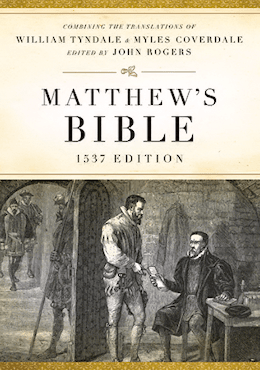Textus Receptus Bibles
Matthew's Bible 1537
| 3:1 | This is the seconde epistle that I nowe wryte to you (beloued) wherwith I stere vp & warne youre pure myndes, to cal to remembraunc |
| 3:2 | the wordes, which were tolde before of the holy prophetes, and also the commaundementes of vs the apostles of the Lorde and sauiour. |
| 3:3 | This fyrst vnderstande, that there shall come in the laste dayes mockers, which wyll walke after their own lustes |
| 3:4 | and say. Where is the promes of hys comminge? For sence the fathers dyed, al thinges continue in the same estate, wherin they were at the beginninge. |
| 3:5 | This they knowe not (and that willinglie) howe that the heauens a greate whyle ago were, & the earth that was in the water, appered vp out of the water by the worde of God, |
| 3:6 | by the which thinges, the worlde that then was, perished ouer flowen with the water. |
| 3:7 | But the heauens verely and earth, which are now are kept by the same worde in store, and reserued vnto fyre, agaynste the daye of iudgemente, and perdycyon of vngodlye men. |
| 3:8 | Dearly beloued, be not ignoraunt of thys one thinge, howe that one daye is wyth the Lorde, as a thousande yeare, and a thousande yeare as one daye. |
| 3:9 | The Lord is not slacke to fulfyl hys promyse, as some men count slaknes, but is patient to vsward and would haue no man loste, but would receyue al men to repentaunce. |
| 3:10 | Neuertheles the daye of the Lord wyl come as a thiefe in the nyght in the which daye, the heauens shal peryshe wyth terryble noyse, and the elementes shal melte wyth heate, and the earth wyth the workes that are therin shal burne. |
| 3:11 | If al these thinges shal perishe, what maner persons ought ye to be in holye conuersacyon and Godlynes: |
| 3:12 | lokynge for and hasting vnto the comminge of the daye of God, in which the heauens shall perishe with fyre, & the elementes shalbe consumed wyth heat. |
| 3:13 | Neuertheles we loke for a new heauen and a newe earth, accordinge to his promys, wherin dwelleth rygtuousnes. |
| 3:14 | Wherfore dearly beloued, seynge that ye loke for such thinges, be diligent that ye may be found of hym in peace, wythout spotte and vndefyled |
| 3:15 | And suppose that the longe suffering of the Lord is saluacion, euen as oure dearlye beloued brother Paule accordinge to the wysdome geuen to hym wrote vnto you, |
| 3:16 | yea, almoste in euery epistle speakinge of such thinges, amonge whiche are manye thinges harde to be vnderstande, which they that are vnlearned, and vnstable, peruert, as they do other scriptures vnto their owne destruccion. |
| 3:17 | Ye therfore beloued, seynge ye knowe it before hand, beware lest ye be also plucked away with the errour of the wycked, and fall from your own stedfastnes, |
| 3:18 | but grow in grace, and in the knowledge of oure Lorde and Sauiour Iesus Christe. To whom be glorye both nowe and foreuer. Amen. |

Matthew's Bible 1537
The Matthew Bible, also known as Matthew's Version, was first published in 1537 by John Rogers, under the pseudonym "Thomas Matthew". It combined the New Testament of William Tyndale, and as much of the Old Testament as he had been able to translate before being captured and put to death, with the translations of Myles Coverdale as to the balance of the Old Testament and the Apocrypha, except the Apocryphal Prayer of Manasses. It is thus a vital link in the main sequence of English Bible translations.